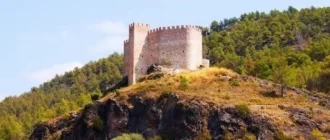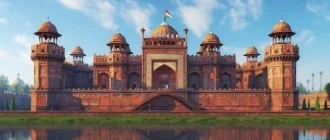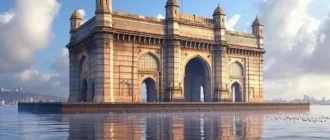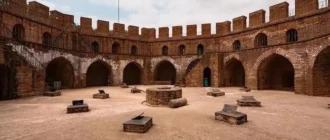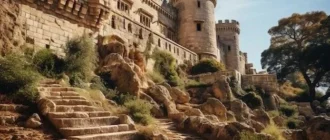Nestled on the shores of the Gulf of Finland, a mere stones throw from St. Petersburg, lies Peterhof Palace – an opulent testament to the grandeur and ambition of Imperial Russia. Often hailed as the “Russian Versailles”, Peterhof transcends mere imitation, weaving its own unique tapestry of majestic palaces, cascading fountains, and meticulously sculpted gardens. This architectural marvel, conceived by Peter the Great and nurtured by successive generations of Russian monarchs, stands as a timeless symbol of Russias imperial might and artistic finesse;
A Tsars Vision: The Genesis of Peterhof
Peterhofs story is inextricably intertwined with the vision of Tsar Peter the Great, a ruler determined to propel Russia onto the world stage. Inspired by his travels to Western Europe, particularly the grandeur of Louis XIVs Versailles, Peter envisioned a palace complex that would not only rival, but surpass, the splendor of its French counterpart. This ambition was not merely driven by a desire for ostentation; Peterhof was to be a tangible manifestation of Russias newfound power and sophistication, a beacon to the world announcing the arrival of a major player on the global stage.
Construction commenced in 1714, a mere four years after Russias decisive victory over Sweden in the Great Northern War. This victory, securing Russias access to the Baltic Sea, was of paramount importance to Peters vision of a modernized, westward-looking Russia. Peterhof, strategically situated on the Gulf of Finland, served as a grand entrance to the new capital, St. Petersburg, and a symbol of Russias imperial ambitions.
The Master Architects of Peterhof
To realize his grand vision, Peter the Great enlisted the talents of some of the most celebrated architects of the era. Domenico Trezzini, a Swiss-Italian architect who played a pivotal role in shaping the architectural landscape of St. Petersburg, was entrusted with the design of the Grand Palace, the centerpiece of the Peterhof complex. Trezzini, a master of the Petrine Baroque style, skillfully blended elements of Russian architectural tradition with Western European influences, creating a style that was both imposing and elegant.
The gardens of Peterhof, spanning over 250 acres, were initially laid out by the French landscape architect Jean-Baptiste Alexandre Le Blond, a proponent of the formal French garden style. Le Blonds design, characterized by geometric layouts, symmetrical parterres, and intricate patterns, provided a fitting setting for the palaces grandeur. Later additions and modifications to the gardens were overseen by other renowned landscape architects, ensuring that Peterhofs green spaces remained a harmonious blend of natural beauty and artistic design.
The Grand Palace: A Symphony in Gold and Marble
The Grand Palace, perched atop a natural terrace overlooking the Grand Cascade, stands as the undisputed heart of Peterhof. This sprawling edifice, its façade stretching over 980 feet, is a masterpiece of Petrine Baroque architecture, its vibrant yellow walls adorned with white columns, gilded statues, and intricate carvings. The palaces interior is no less impressive, a dazzling display of opulence and artistry, with each room boasting a unique theme and lavish decorations.
Among the palaces most notable interiors is the Chesma Hall, commemorating the Russian victory over the Turkish fleet at the Battle of Chesma in 1770. The halls walls are adorned with twelve monumental paintings by German artist Jacob Philipp Hackert٫ vividly depicting the naval engagement and celebrating Russias naval prowess. The Grand Throne Room٫ used for official receptions and ceremonies٫ is another highlight٫ its gilded walls and ceiling adorned with allegorical paintings and portraits of Russian rulers.

The Fountains of Peterhof: A Choreography of Water
While the palaces of Peterhof are undoubtedly impressive, it is the fountains that truly set this complex apart. Over 150 fountains, each with its own unique design and character, grace the gardens of Peterhof, transforming the landscape into a mesmerizing choreography of water and light. These fountains, fed by natural springs and operating without the aid of pumps, are a testament to the ingenuity of 18th-century hydraulic engineering.
The Grand Cascade, cascading down from the foot of the Grand Palace, is the undisputed star of the show. This monumental ensemble, featuring over 60 fountains and 200 sculptures, is a masterpiece of Baroque theatricality. At its heart stands the Samson Fountain, depicting the biblical hero tearing open the jaws of a lion, symbolizing Russias victory over Sweden in the Great Northern War. As water bursts forth from the lions maw, reaching heights of over 65 feet, it creates a spectacle that is both awe-inspiring and unforgettable.
Beyond the Grand Palace: Exploring the Gardens of Peterhof
Beyond the Grand Palace and the Grand Cascade, the gardens of Peterhof offer a seemingly endless array of delights. The Lower Park, laid out in a formal French style, is a masterpiece of geometric design, with its meticulously manicured lawns, symmetrical parterres, and ornate fountains. The Upper Garden, located directly behind the Grand Palace, offers a more intimate setting, with its shady alleys, secluded grottos, and whimsical fountains.
Scattered throughout the gardens are numerous smaller palaces and pavilions, each with its own unique charm and history. Monplaisir Palace, Peter the Greats beloved summer retreat, offers a glimpse into the Tsars more personal side. The Hermitage Pavilion, perched on the edge of the Gulf of Finland, was used for private dinners and gatherings. Marly Palace, inspired by Louis XIVs retreat at Marly-le-Roi, served as a guesthouse for distinguished visitors.
Peterhof: A Legacy of Resilience and Renewal
Peterhofs history, however, is not without its dark chapters. During World War II, the palace complex was occupied by Nazi forces for two years, suffering extensive damage. The fountains were shut down, statues were dismantled and shipped to Germany, and many of the palaces were looted and burned. The Grand Palace, though heavily damaged, miraculously survived the war, thanks in part to the efforts of museum staff who risked their lives to hide some of its treasures.
Following the war, a massive restoration effort was undertaken, bringing Peterhof back to its former glory. Today, the palace complex stands as a symbol of resilience and renewal, a testament to the enduring power of art and beauty to transcend even the darkest of times; Peterhof remains one of Russias most popular tourist destinations, attracting millions of visitors each year who come to marvel at its architectural splendor, its cascading fountains, and its evocative gardens. A visit to Peterhof is not just a journey back in time; it is an experience that engages all the senses, leaving a lasting impression on the soul.
Peterhof Today: A Cultural Legacy Preserved
Today, Peterhof stands as a testament to the vision of its founder and the enduring spirit of Russian artistry. Designated a UNESCO World Heritage Site in 1990, the palace complex is not merely a static monument to a bygone era but a vibrant cultural center that continues to evolve and captivate. Extensive restoration efforts, ongoing since the post-war period, ensure the preservation of Peterhofs architectural marvels, its intricate fountain systems, and its meticulously designed gardens.
Beyond its architectural and historical significance, Peterhof is a living museum, its palaces furnished with period furniture, art collections, and decorative objects that offer a glimpse into the lives and tastes of the Russian Imperial Court. Visitors can wander through the opulent state rooms, imagine grand balls held in the ballrooms, and appreciate the intricate details of the palaces interiors, from the ornate ceilings to the meticulously crafted parquet floors.
A Cultural Destination for the World
Peterhof is a major draw for visitors from around the globe, offering a diverse range of experiences. Guided tours provide historical context and insights into the palace complex, while themed exhibitions delve deeper into specific aspects of Peterhofs past, such as the history of its fountains or the lives of the Romanovs who resided there. The palace gardens, with their sprawling lawns, shady groves, and hidden grottos, provide a tranquil escape from the bustling city and an opportunity to appreciate the beauty of nature intertwined with human artistry.
Throughout the year, Peterhof hosts a variety of cultural events, from classical music concerts held in the palaces grand halls to open-air theatrical performances staged against the backdrop of the Grand Cascade. The annual fountain festival, held in May, marks the official opening of the fountain season, transforming Peterhof into a magical spectacle of water, music, and light. These events, along with the ongoing preservation efforts, ensure that Peterhof remains a vibrant and engaging destination for generations to come.
A Legacy of Inspiration
Peterhof stands as more than just a collection of beautiful buildings and gardens; it embodies the ambition, artistry, and resilience of a nation. It serves as a reminder of the power of human creativity to transform even the most ambitious visions into reality and the enduring legacy of cultural heritage that continues to inspire and captivate us today.

A Symphony of Symbolism: Deciphering Peterhofs Design
Peterhofs grandeur extends beyond its immediate visual appeal; its a meticulously crafted narrative of Russian power and ambition. Peter the Great envisioned his “Russian Versailles” as a celebration of Russias newfound status as a major European power, and every element, from the grand layout to the smallest sculptural detail, contributes to this message.
The choice of a westward-facing palace, gazing out towards Europe, embodies Peters desire to align Russia with the West, embracing its cultural and technological advancements. The Grand Cascade itself, with its triumphant sculptures and cascading waters, becomes a powerful allegory. Samsons victory over the lion directly references Russias triumph over Sweden in the Great Northern War, solidifying the association of Peterhof with national victory and dominance.
Further symbolism abounds: the abundance of gold leaf speaks of opulence and imperial might, while the numerous fountains, representing control over the very element of water, allude to Russias naval aspirations and growing maritime power. Even the gardens, meticulously designed in the formal French style, convey a sense of order imposed on nature, reflecting Peters vision for a modernized and disciplined Russia.

Experiencing Peterhof: A Journey for the Senses
A visit to Peterhof transcends a mere sightseeing tour; its an immersive experience. Stepping off the hydrofoil from St. Petersburg, one is greeted by the shimmering golden dome of the Grand Palace, a beacon against the backdrop of meticulously landscaped gardens. The sound of cascading water from the Grand Cascade fills the air, a symphony of splashing and gurgling that accompanies visitors as they explore the grounds.
Walking through the Upper Garden, one encounters hidden grottos and trick fountains, designed to surprise and delight. The scent of carefully cultivated flower beds mingles with the salty tang of the nearby Gulf of Finland, creating a unique sensory experience. Inside the palaces, the opulence of the Russian Imperial Court comes alive. Intricate parquet floors, glittering chandeliers, and walls adorned with silk damask and masterpieces of European art transport visitors back to a time of lavish balls and courtly intrigue.
A Living Legacy: Peterhof in the 21st Century
Peterhof continues to enthrall and inspire, its legacy extending far beyond its historical significance. The palace complex has become a symbol of Russias cultural resurgence, meticulously restored and maintained as a source of national pride. It serves as a platform for cultural exchange, hosting international exhibitions and events that draw visitors from all corners of the globe.
More than just a tourist destination, Peterhof is a living testament to the enduring power of art, architecture, and human ambition. It stands as a reminder that even in the face of adversity, beauty and creativity can prevail, leaving an indelible mark on the world and inspiring generations to come.

The Enduring Allure of Peterhof: A Timeless Masterpiece
Peterhof Palace, in its totality, transcends the label of a mere historical landmark; it stands as a testament to the enduring power of artistic vision, engineering ingenuity, and the symbiotic relationship between human creation and the natural world. The meticulously designed gardens, stretching out as if in conversation with the Gulf of Finland, embody a harmonious balance between geometric precision and the untamed beauty of the natural landscape.
The interplay of light and water, a defining feature of Peterhof, creates an ever-shifting spectacle. The cascading fountains, each with its unique character and symbolism, transform the gardens into an open-air theater of movement and sound. From the grandeur of the Grand Cascade, a symphony of water and gilded sculpture, to the whimsical trick fountains concealed within secluded groves, Peterhof offers a delightful interplay of surprise and awe.
A Legacy Forged in Time: From Imperial Residence to National Treasure
Throughout its history, Peterhof has witnessed periods of both triumph and tribulation. The ravages of war, particularly during the Second World War, left their mark on the palace complex. However, like a phoenix rising from the ashes, Peterhof underwent a painstaking process of restoration, a testament to the resilience of both the human spirit and the enduring power of art and culture.
Today, Peterhof stands not only as a symbol of imperial Russia but as a source of national pride and unity. It serves as a vital link to the past, preserving the artistic and cultural heritage of a nation while simultaneously embracing its future as a center for cultural exchange and dialogue. The palace museums, with their rich collections of art, furniture, and decorative objects, offer visitors a glimpse into the lives and tastes of the Russian Imperial Court. Exhibitions and events held throughout the year provide further insights into the history, art, and culture of Peterhof and its enduring legacy.
An Invitation to Explore: Embark on a Journey of Discovery
Peterhof Palace beckons travelers, history enthusiasts, and art lovers alike to embark on a journey of discovery. Whether strolling through the manicured gardens, marveling at the intricate fountain systems, or immersing oneself in the opulence of the palace interiors, a visit to Peterhof is an experience that engages all the senses and leaves a lasting impression. It is a place where history comes alive, where the echoes of the past mingle with the vibrancy of the present, and where the enduring power of human creativity continues to inspire and captivate.
Beyond the immediate impact of its visual splendor, Peterhof Palace stands as a profound testament to Russias intricate history, artistic ingenuity, and the enduring power of human ambition. Conceived as a “window to the West” by Peter the Great, the palace complex embodies a pivotal moment in Russias cultural and political evolution, marking its emergence as a major European power.
Architectural Narratives: A Fusion of Russian Vision and European Influence
Peterhofs architectural language represents a fascinating fusion of Russian vision and European inspiration. While drawing upon the grandeur and opulence of Versailles, Peterhof transcends mere imitation, infusing its design with distinctly Russian elements. The use of vibrant colors, particularly the signature yellow and white palette, distinguishes Peterhof from its European counterparts, lending it a sense of warmth and festivity.
The influence of Italian Baroque architecture is evident in the work of Domenico Trezzini, the palaces principal architect. Trezzinis masterful use of symmetry, proportion, and dramatic architectural elements, such as towering columns and elaborate cornices, imbues Peterhof with a sense of grandeur and imperial might. However, these European influences are seamlessly integrated with traditional Russian architectural motifs, such as the onion domes found on some of the smaller pavilions, creating a unique blend of East and West.
A Cultural Tapestry: The Evolution of Peterhof Through Time
Peterhofs story extends far beyond its initial construction, evolving over centuries as a reflection of Russias changing political landscape and cultural sensibilities. Each successive ruler, from Empress Elizabeth to Catherine the Great, left their mark on the palace complex, commissioning additions and alterations that reflected their personal tastes and the prevailing artistic trends of their time.
The reign of Empress Elizabeth, known for her love of luxury and extravagance, ushered in a period of Rococo influence at Peterhof. The interiors of the palace were transformed with lavish decorations, characterized by delicate pastel hues, intricate gilded details, and an abundance of mirrors and crystal. Catherine the Great, a patron of the arts and sciences, continued to expand and enrich Peterhof, adding libraries, theaters, and museums to its grounds, transforming it into a vibrant center of cultural and intellectual life.
Preservation and Renewal: Safeguarding a Legacy for Future Generations
The 20th century brought about a period of unprecedented upheaval and change for Russia, and Peterhof, like many of the nations cultural treasures, faced its share of challenges. The devastation inflicted during World War II served as a stark reminder of the fragility of cultural heritage. Yet, from the ashes of war emerged a renewed determination to preserve and restore Peterhof to its former glory.
Today, Peterhof stands as a testament to the power of human resilience and the enduring importance of cultural preservation. The meticulous restoration efforts undertaken in the decades following the war have returned Peterhof to its former splendor, ensuring that future generations can continue to marvel at its beauty and draw inspiration from its rich history. As a UNESCO World Heritage site, Peterhof now holds a place of honor on the world stage, recognized for its outstanding universal value and its significance to the collective memory of humankind.
A Timeless Dialogue Between Art and Nature: The Gardens of Peterhof
While the architectural grandeur of Peterhof Palace commands immediate attention, it is the seamless interplay between man-made artistry and the natural landscape that elevates the complex to a realm of unparalleled beauty. The gardens of Peterhof are not mere decorative appendages to the palaces but rather integral components of a carefully orchestrated aesthetic experience, designed to evoke wonder, delight, and a profound connection to the natural world.
Conceived on a grand scale, the gardens unfold as a series of interconnected outdoor “rooms,” each with its own distinct character and ambiance. Formal parterres, their meticulously clipped hedges and vibrant floral displays arranged in intricate geometric patterns, speak to the Enlightenment ideals of order and rationality. Yet, this formal structure never feels rigid or contrived, for it is softened by the presence of cascading fountains, shimmering reflecting pools, and strategically placed sculptures that add an element of dynamism and surprise.
Water as Spectacle: The Fountains of Peterhof
No other element defines the gardens of Peterhof more profoundly than water. Peter the Great, fascinated by the hydraulic engineering he had witnessed on his European travels, envisioned a system of fountains that would surpass anything the world had ever seen. Harnessing the natural elevation of the terrain and employing gravity-fed systems, Peterhofs engineers created a hydraulic masterpiece, a symphony of water that animates the gardens with movement and sound.
From the theatrical grandeur of the Grand Cascade, with its 64 individual fountains and over 30 gilded statues, to the playful trick fountains concealed within secluded groves, water at Peterhof is more than just a decorative element; it is a dynamic force that shapes the visitors experience. The unexpected spray of a hidden jet, the roar of water cascading down marble steps, the gentle murmur of a fountain in a secluded grotto – these sensory experiences transform the gardens into a place of constant delight and surprise.
A Legacy of Inspiration: Peterhofs Enduring Influence
The legacy of Peterhof Palace and Gardens extends far beyond the boundaries of its meticulously manicured grounds. As a testament to the creative spirit and ambition of Peter the Great, Peterhof has served as a source of inspiration for generations of architects, landscape designers, and artists. Its influence can be seen in palace complexes and gardens throughout Russia and beyond, each drawing upon Peterhofs unique blend of grandeur, artistry, and harmonious integration of art and nature.
Today, Peterhof stands not only as a monument to a bygone era but as a vibrant cultural destination, welcoming visitors from all corners of the globe to experience its timeless beauty and immerse themselves in its rich history. It is a place where the echoes of the past resonate with the vibrancy of the present, where the boundaries between art and nature blur, and where the human spirit finds expression in the enduring power of creativity.

